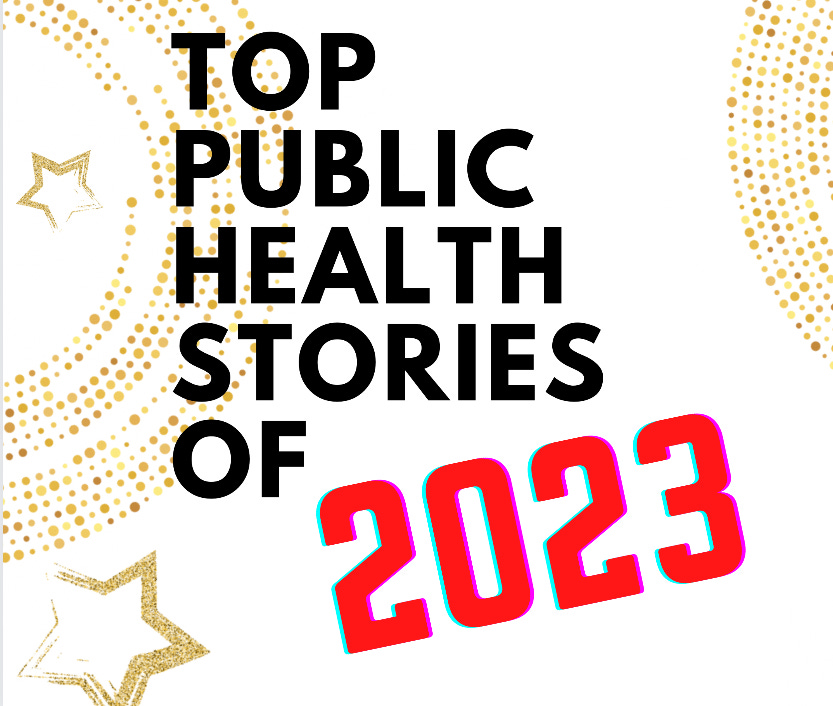Three Things Thursday highlights three things I am paying attention to as an epidemiologist each week.
It is nearly 2024. Just three days away from the new year.
Personally, I subscribe to the philosophy that the week before New Years should be spent enjoying family and friends, reading good books, getting outside, and going on adventures (when possible). With weather in the 60s this week, we’ve been able to get outside and enjoy some fresh air, beautiful spaces, and each other.
Next week I will turn my attention to my goals and plans for 2024, including a new blog series about reading, interpreting, and applying epidemiological research/publications AND my predictions for 2024.
This week we’re looking back at the top stories of 2023 — taking a moment to reflect and remember what has happened this year. And rest assured that these three stories are the prequel to the post about what to expect in 2024.
Hoping this post helps to educate and empower you
to be healthy and create healthy communities.
End of the COVID Public Health Emergency
May 11th marked the official end of the COVID-19 public health emergency. By May 2023, many of us had moved beyond COVID — we are back at school and work (without masks), we were not quarantining individuals who may have been exposed to COVID, and we were no longer fearing that every sniffle or fever is the SARS-CoV-2 virus.
As a reminder, the end of the Public Health Emergency was a political, administrative, and economic phenomenon. It was NOT a medical phenomenon. And by this I mean, that the SARS-CoV-2 virus has NOT disappeared from our communities. Unfortunately, the virus is still spreading. In the past week, COVID hospitalizations have increased 10.4% and deaths are up by 3.4%. Increases are highest in infants and seniors.
By ending the public health emergency, we declared that we have safe and effective vaccines to prevent severe illness and death. We have tests to diagnose COVID. And we have effective treatments to help those who have COVID clear the virus quickly.
COVID is no longer a disease we are unprepared for.
The SARS-CoV-2 virus will continue to circulate in our communities. It will continue to cause illness and death. But we understand the virus. We have systems in place to gather case data and wastewater data. We are monitoring for new variants. And we are have annual COVID vaccinations in place.
COVID isn’t gone. But it is NO LONGER an emergency.
Global Vaccination Rates Declining (on the whole)
According to reports out in November, here in the US — a record number of parents/guardians have opted for non-medical exemptions to routine vaccinations given to children before they enter kindergarten. And worldwide, vaccine coverage, specifically the measles vaccine, has decreased; resulting in an 18% increase in measles cases and a 43% increase in measles deaths in 2022 compared with 2021.
The reasons for the decline in vaccine coverage are a combination of lack of access to care during the pandemic (missed well-check visits for kids during lockdown), misinformation, and physicians/public health professionals who are no longer trusted.
According to the Washington Post —
“…even before the pandemic, more parents in an increasing number of states opted their children out of required immunizations because of vaccine hesitancy and anti-vaccine sentiment, according to data and experts. The pandemic magnified those concerns because of controversies and politicization around coronavirus vaccines and school vaccine mandates.”
I also think that we (collectively) have a short-term memory — the generation of individuals with kids who need their childhood vaccinations do not know, have not experienced, and do not fear the diseases that vaccines prevent. We have little to no experience with polio, measles, mumps, diphtheria, pertussis, or rubella. We do not fear these diseases like our grandparents/parents did.
The public health and medical communities are concerned about the decline in routine vaccinations because the diseases that are vaccine-preventable (measles, pertussis, diphtheria, polio, rubella, tetanus) can cause life-long harm or death. These diseases are deadly — these diseases can kill people, paralyze them for life, or cause financial ruin.
We vaccinate individuals to prevent disease before it occurs because the benefit of the vaccine (and a mild side effect or two) FAR OUTWEIGHS the cost of getting one of these vaccine-preventable diseases.
Vaccines save lives.
Vaccines & Monoclonal Antibodies for RSV Available
On May 3, FDA announced the approval of the first RSV vaccine for adults aged 60 years and older. According to Peter Marks, MD, PhD, director of the FDA’s Center for Biologics Evaluation and Research —
"Today’s approval of the first RSV vaccine is an important public health achievement to prevent a disease which can be life-threatening and reflects the FDA’s continued commitment to facilitating the development of safe and effective vaccines for use in the United States.”
The vaccine — named Arexvy and manufactured by GlaxoSmithKline — was determined to be both safe and effective. According to clinical trial data, the vaccine reduced the risk of RSV-related LRTD by 82.6% and lowered the risk of severe LRTD by 94.1%.
And then in July FDA approved a monoclonal antibody treatment to prevent severe illness from RSV for infants and young children. The following week, the CDC Advisory Committee for Immunization Practices (ACIP) approved this treatment, and then Dr. Mandy Cohen officially approved the use of nirsevimab, trade name BeyfortusTM, a long-acting monoclonal antibody product, for use.
CDC recommends one dose of nirsevimab for all infants younger than 8 months, born during – or entering – their first RSV season (typically fall through spring). For a small group of children between the ages of 8 and 19 months who are at increased risk of severe RSV disease, such as children who are severely immunocompromised, a dose is recommended in their second season.
As we end the year, new data shows that most older adults (who are most at risk to severe illness caused by RSV and who NEED to get the RSV vaccine) opted not to get the shot this fall. Hospitalizations for RSV may be less common than those for flu or COVID-19, but they are more severe and more likely to occur in adults ages 75 and older, according to new data published in Morbidity and Mortality Weekly Report.
2023 was a year of transition.
We moved from a state of emergency to a state of… transition? Endemicity? Confusion? Status quo? Amnesia?
I’m not sure there is a way to capture the state of public health in 2023.
In the field of public health, we went from endless resources back to pre-2020 resources. We added another disease (COVID) to track, new vaccines to educate people about, and increasing levels of misinformation and distrust in our expertise.
2023 included more threats, mean comments, and nasty dismissals of our expertise.
But at the same time, we have new RSV vaccines, a seasonal COVID shot, new dashboards for surveillance data, and a new leader at CDC, who understands that there is work to be done to rebuild relationships, grow trust, and fund public health at levels that will allow us to do the work that needs to be done (behind the scenes) to keep our communities healthy.
As 2023 comes to an end, I extend to you all my birthday blessing again —
May you find time away from your devices.
And may you find family and friends to spend quality time with.
May you get lost in a good book.
May you get outside to enjoy blue skies, fresh air, and the beautiful colors of nature.
And may you be kind to yourself.
And kind to others.
Thank you for spending your time with me throughout 2023. I am grateful that you come back each week (and sometimes more often) to read what I have to say.
Hoping this post helps to educate and empower you
to be healthy and create healthy communities.
Questions? Or suggestions for what I should be highlighting in 2023? Please leave a comment —
And please share this with your friends and family.
Happy New Year!




